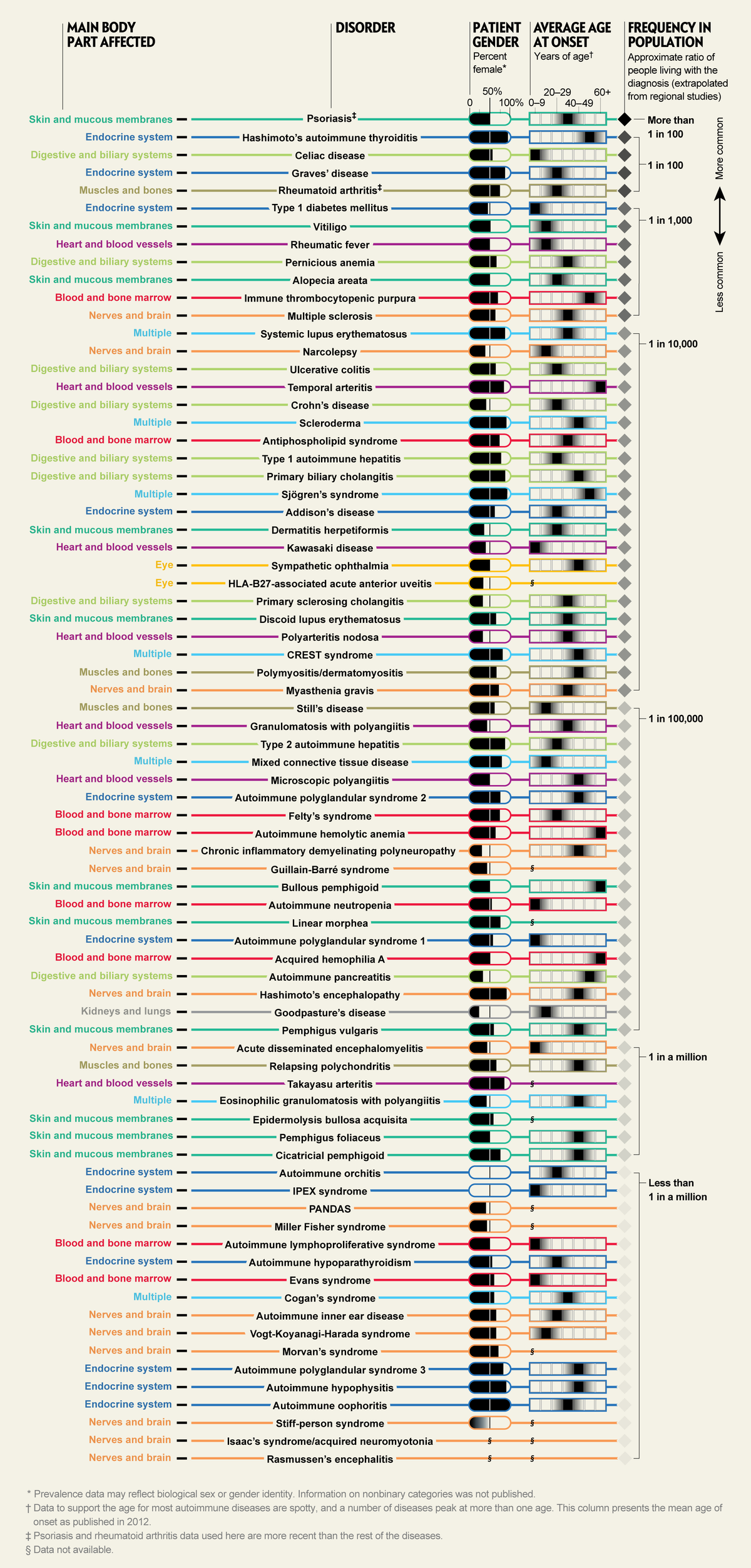The idea that organisms might attack themselves with immune systems that evolved to defend them from diseases in the outside world made little sense to immunologist Paul Ehrlich. In 1901 the future Nobel laureate dismissed such a theory—he called it “horror autotoxicus”—as farfetched. Today patients and physicians know that autoimmune diseases are all too real. There are roughly 80 autoimmune conditions that affect millions of people worldwide. The variety and numbers shown in the chart on the next two pages are daunting.
Autoimmunity involves autoantibodies—immune system proteins that mark an organism’s own tissues for destruction—along with the T and B cells that serve as agents of that assault. Modern techniques of molecular biology, which have allowed scientists to trace these populations of cells and proteins, have helped refine this definition.
But while the broad outlines are clearer than they were in Ehrlich’s day, the details of different illnesses can still be a matter of some dispute. Matthew C. Cook, director of the Center for Personalized Immunology at Australian National University’s John Curtin School of Medical Research in Canberra, notes that even in diseases in which scientists do not consistently detect autoantibodies related to pathology, drugs that modulate T cells can be used successfully. The skin illness psoriasis is one such example and is often described as an autoimmune disorder.
On supporting science journalism
If you're enjoying this article, consider supporting our award-winning journalism by subscribing. By purchasing a subscription you are helping to ensure the future of impactful stories about the discoveries and ideas shaping our world today.
Our list includes most of the known diseases in an area where scientific understanding is still evolving. It describes the prevalence of these illnesses, the age at which they typically appear, and whether they are more likely to afflict women or men (almost always women).
A WORLD OF AUTOIMMUNITY
The New Science of Autoimmune Disease
There are many autoimmune diseases, and taken together they affect as much as 4.5 percent of the world’s population. This list of 76 disorders is drawn from a detailed analysis by immunologists Scott M. Hayter and Matthew C. Cook, then at Australian National University, that was published in 2012. Scientific American has updated it with information from other autoimmune disease specialists and the Autoimmune Association (formerly the American Autoimmune Related Diseases Association). The illnesses affect different parts of the body, and several strike multiple organs. Women are most frequently afflicted, although the exact gender ratios differ among individual diseases. The approximate average ages of onset and the frequency in the population also vary.
Immunologists and rheumatologists acknowledge that autoimmunity can be a murky research area, and they are still discovering features that characterize a disorder as autoimmune or not. In general, the diseases presented here fall into three categories, based on the strength of evidence that they are driven by an autoimmune response and proteins known as autoantibodies. In the clearest cases, such as Graves’ disease, the illness definitely involves autoantibodies that lead to an immune system assault, inflammation and debilitating symptoms. In many others, including Guillain-Barré syndrome, autoantibodies are often present, but scientists have not been able to tie them consistently to the pathology of the disease. Finally, some disorders do not always show autoantibodies, yet they respond well to treatments that affect the immune system. This response suggests the illnesses have an autoimmune component. Ulcerative colitis and psoriasis are two examples in this group.
Some conditions that have autoantibodies and appear to be related to autoimmunity have been excluded from this list. That is because they were not part of Cook and Hayter’s survey, or they were not on a compendium from the Autoimmune Association, or some autoimmune disease specialists contend that certain biological features made their status debatable. These ailments include myocarditis, neuromyelitis optica, primary membranous nephropathy and thrombotic thrombocytopenic purpura.

Credit: Jen Christiansen (graphic); Miriam Quick (research); Sources: “Updated Assessment of the Prevalence, Spectrum and Case Definition of Autoimmune Disease,” by Scott M. Hayter and Matthew C. Cook, in Autoimmunity Reviews, Vol. 11; August 2012; “Autoimmunity and Autoimmune Co-morbidities in Psoriasis,” by Kazuhisa Furue et al., in Immunology, Vol. 154; February 2018 (psoriasis); “The Global Prevalence of Rheumatoid Arthritis: A Meta-analysis Based on a Systematic Review,” by Khalid Almutairi et al., in Rheumatology International, Vol. 41; May 2021 (rheumatoid arthritis); Consultants: Matthew C. Cook (John Curtin School of Medical Research); DeLisa Fairweather (Mayo Clinic); Aimee Payne (Clinical Autoimmunity Center of Excellence, University of Pennsylvania)
